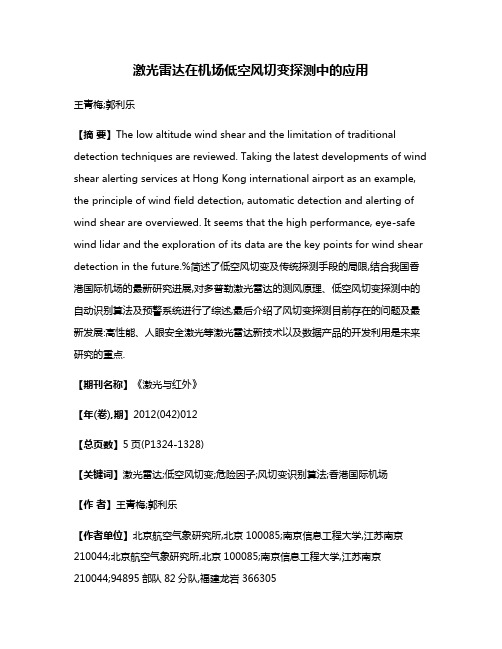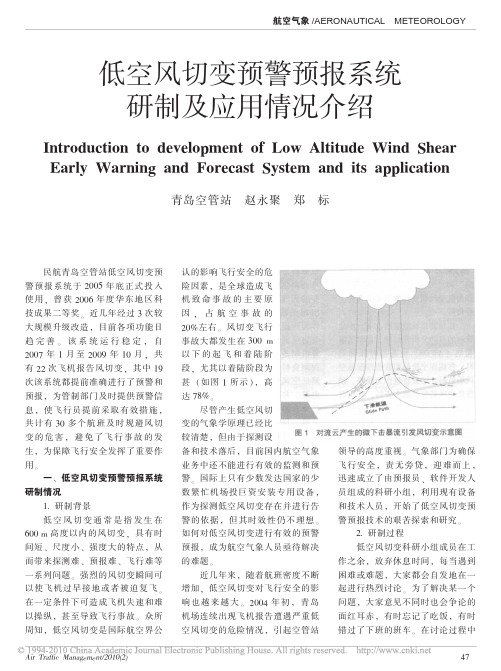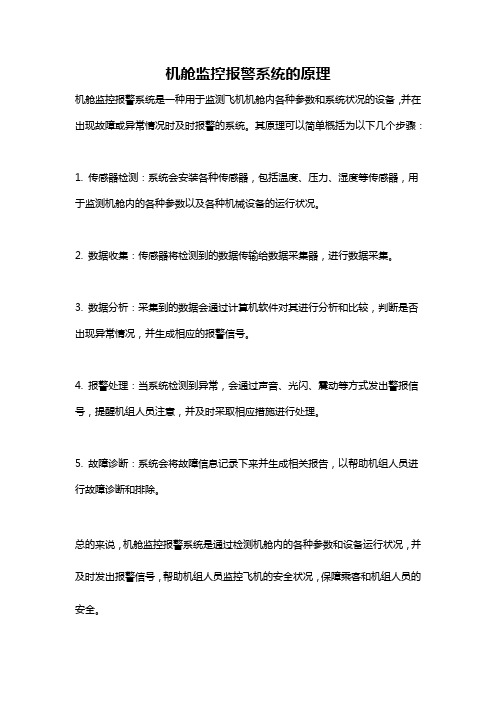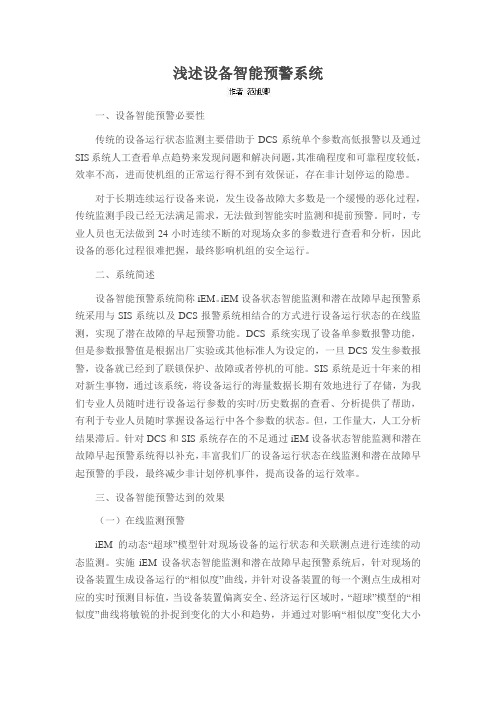航空电子设备 风切变预警系统
理论研究低空风切变预警系统在支线机场的应用

理论研究低空风切变预警系统在支线机场的应用一、项目背景支线机场建设中往往未涉及低空风切变预警系统,但由于山区机场存在常年大风,且目前对低空风切变相关数据存在空白,因此研究低空风切变在山区支线机场的应用显的尤为重要,对今后机场建设低空风切变系统提供理论依据。
本报告通过对低空风切变的理论研究和国际国内相应低空风切变探测产品研究,形成低空风切变系统在支线机场应用的研究报告。
二、风切变的形成及其对飞行的影响低空风切变受到人们的重视并开始对其研究,是在1970年代中期美国航班飞机在起飞降落过程中发生的多起严重飞行事故之后才开始的。
近几十年来,许多国家成立了专门的研究机构,对低空风切变作了广泛的研究,取得了不少的成果。
自1976年国际民航组织正式发出通报要求把低空风切变作为重要研究课题以来,美国、苏联、日本等国和我国的香港天文台即开始了对低空风切变的探测和研究工作,目前已经取得了较好的进展。
我国大陆对低空风切变的研究起步较晚,1980年代中期开始利用气象铁塔资料,对低空风切变进行了分析研究。
但综合目前的技术水平来看,尚有一些问题没有很好解决,还需要进行不懈努力,才能解决低空风切变对航空的危害。
三、低空风切变的形成风切变是指空间两点之间的风的矢量差,风速矢量或其分量沿某一垂直或水平方向的变化,是风空间变化率的一个特性。
航空气象中,风切变一般被分为低空风切变和中高空风切变,距地面高度600米以下的风切变被称为低空风切变,当飞机在起飞或者着陆阶段,高度较低、空速较小的情况下遇到风切变,可能会由于短时间高度、姿态变化大,没有足够的空间修正动作而造成危险。
很多情况下,由于风切变无法直接用肉眼识别出,因此被冠上“隐形杀手”之名。
低空风切变是在一定天气背景和环境条件下形成的,一般有几种天气情况易产生低空风切变。
一种是雷暴、积雨云、龙卷等强对流天气。
强对流天气中有很强的上升和下降气流,能形成很强烈的垂直气流切变。
强的下击暴流到达地面后向四周扩散,可传到离雷暴体20km 处,阵风风速可达20m/s,形成强烈的水平风切变。
737NG飞机预测风切变功能

737NG飞机预测风切变功能在B737NG飞机装载的气象雷达中一个重要的功能是预告风切变。
这和B737-300型飞机不同,在原理、使用和维护上都有所区别,下面将分别加以分析,以便对新一代飞机气象雷达加深了解,提高维护水平。
一、基本原理:相对B737-300型飞机探测风切变的功能是由近地警告计算机通过比较迎角传感器的迎角、IRS的加速度和大气数据计算机的空速三者的关系发现潜在的风切变危险,新一代的737飞机预告风切变功能是通过接收存在风切变的区域大气中垂直运动的气象目标反射的雷达波束并进行处理,然后将风切变信息送到近地警告计算机,由近地警告计算机对近地警告和风切变警告进行优先级排序,给出最高优先级的警告信息显示和话音警告。
二、相关系统及信号交联1、近地警告计算机近地警告计算机在近地警告系统有更高优先级警告时发送抑制离散信号到预告风切变功能模块抑制预告风切变警告。
2、自动油门电门组件自动油门电门组件发送自动油门杆位置作为预告风切变的限定(QFR A)防止除去开始起飞时的在地面时气象雷达的操作。
3、TCAS气象雷达收发机发送音频抑制信号,并使TCAS将所有的TA将级为RA。
4、ADIRSADIRS通过低速429数据总线发送未修正气压高度、修正气压高度、真空速、计算空速等信号到气象雷达收发机用于风切变计算。
5、无线电高度表无线电高度表通过ARINC429总线发送无线电高度到气象雷达收发机用于预告风切变功能。
预告风切变功能使用无线电高度来完成以下功能:——开关预告风切变——使能/失能显示和警告功能6、起落架控制手柄组件起落架控制手柄组件发送模拟离散信号到预告风切变模块用于起飞/进近警告逻辑三、预告风切变工作1、概述预告风切变探测到风切变的危险时产生警告,告警的级别取决于探测到的风切变相对飞机方位的位置、距离和起飞还是着陆。
2、警告和告诫的通告方式预告风切变警告的视觉和听觉通告有:——PFD上红色的WINSHEAR信息——ND上红色的WINSHEAR信息——主警告灯亮——WINSHEAR AHEAD,WINSHEAR AHEAD的音响通告(起飞)——GO AROUND, WINSHEAR AHEAD的音响通告(进近)预告风切变的告诫的视觉和听觉通告有:——ND上琥珀色的WINSHEAR信息——ND上风切变标志——MONITOR RADAR DISPLAY的音响通告3、预告风切变功能的开启和关闭当飞机在地面且发生以下情形之一时预告风切变功能开启:——一台发动机达到起飞推力——机组按下了EFIS控制面板上的WXR按钮如果两台发动机都达到起飞推力,再次按压EFIS控制面板上的WXR按钮并不能关闭预告风切变功能,飞机爬升到无线电高度2300英尺时预告风切变功能自动关闭。
飞机机型知识:CHAPTER15警告系统

系统信号牌指示灯存在注意级情况时,让飞行员更好的判断
相应问题所在的系统.
3
3
系统信号牌指示灯
系统信号牌指示灯
系统信号牌指示灯
系统信号牌指示灯
如图所示系统信号牌 和相应琥珀色指示灯 左侧
过热/探测: 1号发动机过热 2号发动机过热
APU探测器不工作
系统信号牌指示灯
顶板: 设备冷却-关 应急出口灯-未预位 飞行记录器-关 旅客氧气-开 临近电门电子组件 应急定位发射器 YN471-YM484 烟雾
警告系统提供的信息需要引起机组足够的注意。机组 应熟知警告信息内容,熟练处置原则和程序,才可以发挥警 告系统的重要作用!
警告方式和类型识别
红色指示灯
飞行组立即关注的情况由飞行员主要目视区域内的红色警 告指示灯指示。这些指示灯指示发动机、轮舱、货舱或 APU 火警以及自动驾驶、自动油 门脱开和起落架不安全情况。
1. 起飞形态警告指示灯 亮(红): 如飞机未处于正确的起飞形态,在地面前推油门时该指示
灯亮 起飞形态警告的间歇性声响警告喇叭与该指示灯同时启动 2:机舱高度警告指示灯亮(红): 机舱高度超过10,000英尺时该指示灯亮 机舱高度警戒的间歇性声响警告喇叭与该指示灯同时启动 机舱高度下降至低于10,000英尺时该指示灯灭。
系统核心是近地警告计算机计算机中存储了各种警告方式的极限数据这些数据与其它系统输送来的飞机实际状态数据进行比较如这些数据超出了某一种警告方式的极限值近地警告计算机就输出相应的语音和灯光警告信号警告飞行员目前飞机存在危险状态直到采取了适当的措施而脱离了不安全状态后灯光和语音警告信号才被终止
警告系统
部门:培训部 处室:航务教研处
复习思考题
• 737NG机组警告有哪些类型? • 737NG 驾驶舱中红色警告灯亮,说明机组
10第10章 风切变预警系统

航径降低
逆风切变(顺风减小或逆风增大) 航径抬高 (overshoot effect)
侧风切变
偏航、侧滑、滚转
微下击暴流对航空器的影响
逆风切变-下沉气流-顺风切变
微下击暴流对航空器的影响
阵风锋对航空器的影响
逆风切变,航径抬高
海陆风对航空器的影响
逆风切变,航径抬高
风速和风向的快速变化,将导致 飞机颠簸
缺点
1、安装位置选择和保护困难 1、晴天不能使用
2、应用成熟,有可借鉴的方 2、风场反演算法不确定 法和模型 3、安装位置要求高 4、需要专业人员 1、晴天可用 要前期经验积累 激光雷达 集成的业务化 风切变警报系统 1、晴天可用 2、安装要求相对简单 1、全天侯、全方位测量 2、产品可信度高 1、雨天效果差 2、造价较高 1、造价昂贵 2、技术含量高,维护成本大
五、低空风切变气象服务
机场低空风切变资料,来自
起降阶段的航空器空中报告
专用风切变探测设施或系统
地面直接目视观测
基于综合气象信息编制的预报
注: 由于缺乏探测低空风切变的设 备,在大多数机场,风切变信息主要基 于航空器空中报告
低空风切变气象服务
(一)机场天气报告中的低空风切变 情报
(二)低空风切变警报
发生在低层(距地面500米)的风 切变严重影响航空器的起降,将发 生在这一气层中的风切变称为低空 风切变
二、产生低空风切变的条件
(一)强对流天气(阵风锋、下击 暴流、微下击暴流)
(二)锋面
(三)地面大风
(四)地形
(五)辐射逆温型的低空急流 (六)尾涡
(一)强对流天气
下沉气流
阵风锋
雷暴中有强烈的下沉气流,到达地面后向四周散开, 形成强烈的冷性外流向四周传播
第12章 预测式风切变系统《民用运输机航空电子系统》

✅ 精品课件合集
民用运输机航空电子系统
第12章 预测式风切变系统
1
目录 CONTENTS
01 02 03 04 05 06
基本原理 系统限制 报警情况 基本操作 飞行机组程序(A320飞机) CCAR规定
风切变是指风速、风向的突然、迅速变化。它经常出现在雷暴或其他 不稳定的气流中。微下击暴流是风切变的一种最危险形式,严重地威胁着 飞行安全。飞机一旦迚入微下击暴流,将严重限制飞机的最大爬升能力。
飞行机组程序(A320 飞机)
PART 5
05飞行机组程序(A320飞机)
1.PWS警戒:“MONITOR RADAR DISPLAY”
(1)起飞前
①推迟起飞直到条件改善。 ②评估起飞条件: a.凭观察和经验。 b.检查气象条件。
③起飞前选用气象雷达或预测式风切变探测系统以确保飞行航路上没有任何潜在 的危险气象区。
显然,该风切变区域的水平速度分量越大,两侧所产生的多普勒频谱的 中心频率之差就越大。
01基本原理
预测式风切变系统对飞机前方5nmile范围内的大气迚行扫描,识别是否 有风切变,其有效报警范围为飞机前方3nmile,如图12.2所示。在某些飞 机上,若探测到风切变位于飞机前方35nmile之间,会出现咨询显示。
系统限制
PART 2
02系统限制
多普勒气象雷达有其固有的局限性,不能探测垂直风和某些大气条件。 多普勒气象雷达系统只能检测水平风速,垂直风速根据测得的水平风 速迚行推算。气象雷达收发机中的软件假设所有检测到的水平风分量不垂 直风分量成正比。通过将检测到的水平风分量加到假设的垂直风分量中来 确定风切变的大小。
02系统限制
多普勒气象雷达不能检测没有包含有一定数量的水分或微粒的大气,因 为水分或微粒才能将雷达波反射回天线。PWS主要用于检测微下击暴流之类 的风切变。其他形式的风切变,如侧风切变和飑锋等,如果具有以下特征, 也可以检测: ➢ 包含有水平风分量 (通过多普勒频偏检测)。 ➢ 包含有一定数量的水分或微粒。
低空风切变预警预报系统简要说明

低空风切变预警预报系统简要说明青岛空管站2006年4月一、风切变及系统概述二、风切变主要表现形式三、预警预报指标四、预报思路及指标应用五、实例分析一、风切变及系统概述风切变是指逆风或顺风出现持续的转变(持续至少数秒钟)而引致飞机的浮力产生变化。
浮力减少可导致飞机向下偏离预定飞行路线。
引致逆风或顺风出现15海里/小时(8米/秒)或以上的转变为显著的风切变。
风切变表现为气流运动速度和方向的突然变化。
飞机在这种环境中飞行,相应地就要发生突然性的空速变化,空速变化引起了升力变化,升力的变化又引起了飞行高度的变化。
风切变按风的切变类型可分为垂直风切变、水平风切变和垂直风的切变。
低空风切变通常是指发生在500米高度以内的风切变,具有时间短、尺度小、强度大和突发性的特点。
雷暴、锋面、强气旋、低空急流、低空逆温、地形等都会造成强低空风切变。
严重的低空风切变,常发生在低空急流、锋面及雷雨云附近。
山东半岛地形图流亭机场地形图(50KM)流亭机场地形图(10KM)流亭机场飞机着陆路径35号跑道(南向北)对准跑道时距机场25KM,高度900米,约5-6分钟后落地;高度500米时,距机场10KM(沧口机场)。
17号跑道(北向南)对准跑道时距机场20KM,高度550米,约5-6分钟后落地。
系统主页系统结构图气象资料气象自动观测系统气象要素实时风向风速、气温、场压探测资料 气象局探空资料JMA(CMA)T213数值预报产品中地面和低空风场资料资料说明未来资料引进1)青岛市气象局设置在机场周围自动气象站资料、多普勒雷达反演风场资料的应用。
2)MM5数值预报产品的应用。
3)风廓线雷达设备的引进和资料应用。
4)反向指标应用。
如能见度(RVR),大雾出现时,低层稳定,一般不会出现低空风切变。
当风场预报资料不准时,可以用来进行订正。
比如锋面过境时,预报低空风转向比实际早,地面风实际风向未转时,系统会误报警,通过参考能见度资料可以进行订正。
一文读懂:起飞遭遇风切变、预警式风切变、PWS抑制

一文读懂:起飞遭遇风切变、预警式风切变、PWS抑制风切变探测分类:风切变警戒按照发生的时间和基于的系统分两个:•基于增强型近地警告系统在遭遇风切变时的警戒信息(空客是基于FAC的叫反应式风切变警告信息)•基于气象雷达探测到预计会有风切变的预警式风切变警戒信息1 基于增强型近地警告系统可以在飞机遭遇风切变时产生风切变注意级警戒信息和风切变警告级警戒•出现风切变警告级警戒时会伴随出现姿态指示器上红色的WINDSHEAR(风切变)信息和语音警戒。
•出现风切变注意级警戒时会伴随出现语音警戒。
2 基于气象雷达探测的预警式风切变又分为预警式风切变注意(Caution)和预警式风切变警告(Warning)。
空客飞机还有咨询信息(Advisory)。
中断起飞:在波音737和空客320的使用手册中高速阶段中断起飞是这样写的:(注意波音认为80节以上是高速阶段,空客认为100节以上)波音737FCOM:80海里/小时以上且在V1前,出现以下任一情况时中断起飞:•火警或火警警告•发动机失效•预警式风切变警告•如飞机状态不安全或不能飞行。
在《精飞空客320》中是这样写的:•失火警告或严重损坏•发动机推力突然丧失•故障或条件明确无误地表明飞机不能安全飞行•任何红色的ECAM警告•任何琥珀色的ECAM注意列在下面:- F/CTL SIDESTICK FAULT(飞行操纵侧杆故障)- ENG FAIL(发动机失效)- ENG REVERSER FAULT(发动机反推故障)- ENG REV UNLOCKED(发动机反推未锁定)- 发动机 1(2) 推力手柄故障对于320飞机,高速阶段中断起飞没有预警式风切变警告这一项,原因是在超过100节到离地50英尺之间,预警式风切变警告是被抑制的。
遭遇风切变警告工作时机:基于增强型近地警告系统的风切变警告系统:•波音737飞机是在离地时才开始工作,一直工作到1500英尺•空客320飞机在离地3秒和1200英尺之间提供风切变警告预警式风切变警告抑制基于气象雷达的预警式风切变在起飞的部分阶段是被抑制的:•在波音737新的手册中,起飞和着陆阶段,速度80节到无线电高度400英尺之间,新的风切变预警注意信息被抑制,速度100节到无线电高度50英尺之间,新的预警警告信息被抑制。
激光雷达在机场低空风切变探测中的应用

激光雷达在机场低空风切变探测中的应用王青梅;郭利乐【摘要】The low altitude wind shear and the limitation of traditional detection techniques are reviewed. Taking the latest developments of wind shear alerting services at Hong Kong international airport as an example, the principle of wind field detection, automatic detection and alerting of wind shear are overviewed. It seems that the high performance, eye-safe wind lidar and the exploration of its data are the key points for wind shear detection in the future.%简述了低空风切变及传统探测手段的局限,结合我国香港国际机场的最新研究进展,对多普勒激光雷达的测风原理、低空风切变探测中的自动识别算法及预警系统进行了综述,最后介绍了风切变探测目前存在的问题及最新发展:高性能、人眼安全激光等激光雷达新技术以及数据产品的开发利用是未来研究的重点.【期刊名称】《激光与红外》【年(卷),期】2012(042)012【总页数】5页(P1324-1328)【关键词】激光雷达;低空风切变;危险因子;风切变识别算法;香港国际机场【作者】王青梅;郭利乐【作者单位】北京航空气象研究所,北京100085;南京信息工程大学,江苏南京210044;北京航空气象研究所,北京100085;南京信息工程大学,江苏南京210044;94895部队82分队,福建龙岩366305【正文语种】中文【中图分类】TN958.981 引言低空风切变是国际航空和气象界公认的飞机起飞和着陆阶段的“无形杀手”。
航空器系统系列-气象雷达系统!

航空器系统系列-气象雷达系统!气象雷达系统WEATHER RADAR SYSTEM气象雷达系统的故障在日常维护中比较常见,接下来通过翻译SDS让我们再次学习一下这个系统,以夯基础。
介绍WXR系统提供下列视觉信息显示在CDS上:•气象状况•风切变事件•陆地轮廓气象雷达的操作和回波的原理一样。
WXR向飞机前方180度区域发射射频脉冲,目标对象将脉冲反射回来给接收器,接收器处理返回波信号用于显示气象、地形和风切变事件。
气象雷达收到的反馈信号转换成四种不同的颜色出现在导航显示器(ND),这四种不同颜色给机组提供了回波信号的强度。
前视风切变提醒和警告在ND和PFD上显示为琥珀色和红色。
同样前视风切变提醒和警告也伴随音频警告。
一般描述以下部件提供气象雷达系统的控制:•左右EFIS控制面板•气象雷达控制面板系统输入以下部件给气象雷达收发机的前视风切变提供信号:•ADIRS为PWS发送大气数据•在起飞和进近阶段,无线电高度表发送高度数据来激活或者不激活PWS•在起飞阶段,自动油门电门组件激活PWS•在进近阶段,起落架手柄电门发送起落架放下离散信号来激活PWS•空地继电器发送空地离散信号用于飞行航段计算。
系统输出气象雷达收发机发送以下信号用于前视风切变:•到WXR/TERR继电器的PWS视频•将PWS的警告和提醒送到GPWS来优先于其他输出•当有PWS警告时,TCAS音响抑制•给REU提供音频用于PWS显示WXR数据显示在ND上,来自气象雷达收发机的气象数据发送到气象雷达/地形(WXR/TERR)继电器。
近地警告计算机(GPWC)控制和开关该继电器。
如果在EFIS控制面板上选择了TERR,或者GPWC有地形警戒或者地形净空警告输出,然后EGPWS地形数据就显示在ND上了。
如果未选择TERR并且没有EGPWS警告,WXR数据就显示在ND上。
天线气象雷达天线发送射频脉冲信号并接收射频回波,收发机通过ADIRU得到俯仰和横滚角度用于稳定天线,一般情况下收发机从左ADIRU得到数据。
低空风切变预警预报系统研制及应用情况介绍

青岛空管站 赵永聚 郑 标
民航青岛空管站低空风切变预 警 预 报 系 统 于 2005 年 底 正 式 投 入 使 用 , 曾 获 2006 年 度 华 东 地 区 科 技成果二等奖。 近几年经过 3 次较 大规模升级改造, 目前各项功能日 趋完善。 该系统运行稳定, 自 2007 年 1 月 至 2009 年 10 月 , 共 有 22 次飞机报告风切变, 其中 19 次该系统都提前准确进行了预警和 预报, 为管制部门及时提供预警信 息, 使飞行员提前采取有效措施, 共计有 30 多 个 航 班 及 时 规 避 风 切 变的危害, 避免了飞行事故的发 生, 为保障飞行安全发挥了重要作 用。
不同原因造成的测向误差, 可 NDB 设 备 发 送 调 幅 键 控 信 号 时 , 射效率将大幅度的降低。 考虑到地
以根据飞行效验报告提供的数据来 输出的峰值功率很大, 会有拉弧放 波 部 分 信 号 对 NDB 导 航 台 测 向 准
机场气象设备实施方案

机场气象设备实施方案一、引言随着航空业的快速发展,机场气象设备的重要性日益凸显。
气象条件对飞行安全有着至关重要的影响,因此机场气象设备的实施方案显得尤为重要。
本文将详细介绍机场气象设备的实施方案,以确保飞行安全和航班正常运行。
二、机场气象设备的种类机场气象设备主要包括气象雷达、自动气象站、风切变预警系统、风速测量仪等。
这些设备能够提供及时准确的气象信息,帮助飞行员和航空管制人员做出正确的决策,确保航班的安全起降和飞行。
三、机场气象设备的实施方案1. 气象雷达气象雷达是一种通过发送和接收微波信号来探测附近天气情况的设备。
在机场,气象雷达通常安装在塔台附近的高处,以便获取更广泛的气象信息。
在实施气象雷达时,需要考虑雷达的位置、高度和覆盖范围,以确保能够有效地监测到附近的气象变化。
2. 自动气象站自动气象站能够自动地测量和记录气象要素,如温度、湿度、气压、风速和风向等。
在机场,自动气象站通常分布在跑道附近和机场周边,以提供准确的气象信息。
在实施自动气象站时,需要考虑站点的选择、布设方式和数据传输方式,以确保能够及时准确地获取气象信息。
3. 风切变预警系统风切变是一种在短时间内风速和风向发生急剧变化的现象,对飞机飞行安全有着严重的影响。
因此,在机场附近安装风切变预警系统是非常重要的。
在实施风切变预警系统时,需要考虑系统的灵敏度、覆盖范围和响应时间,以确保能够及时准确地预警风切变现象。
4. 风速测量仪风速测量仪是一种用于测量风速和风向的设备,能够帮助飞行员和航空管制人员了解当前的风况。
在机场,风速测量仪通常安装在跑道附近和塔台附近,以提供准确的风速和风向信息。
在实施风速测量仪时,需要考虑设备的精度、稳定性和可靠性,以确保能够准确地测量风速和风向。
四、机场气象设备的维护和管理除了实施机场气象设备外,维护和管理也是非常重要的。
机场气象设备需要定期进行检查和维护,以确保设备的正常运行和数据的准确性。
此外,还需要建立健全的数据管理和共享机制,以便不同部门和单位能够及时准确地获取气象信息。
基于激光雷达和航空器报告识别低空风切变及其演变过程研究

基于激光雷达和航空器报告识别低空风切变及其演变过程研究基于激光雷达和航空器报告识别低空风切变及其演变过程研究低空风切变是指风速和方向在短时间和空间内产生剧烈变化的现象。
它是一种严重危及飞行安全的天气现象,可以导致飞机失速、推力不足、失控等飞行异常情况。
因此,对低空风切变的研究具有重要意义。
本文基于激光雷达和航空器报告的数据,对低空风切变及其演变过程进行了研究。
首先,我们使用激光雷达技术对目标区域进行风场探测。
激光雷达可以通过测量大气中的湍流运动来获取风速和方向等风场参数。
我们选取了北京某机场为研究区域,通过设置激光雷达传感器在机场附近进行连续观测。
观测过程中,我们记录了激光雷达的反射信号和探测得到的风场参数。
通过数据处理和分析,我们得到了该区域风场的时空分布特征。
然后,我们收集了航空器报告(PIREPs)的数据。
航空器飞行过程中会不断向地面站发送飞行状况报告,其中包括关于风场、气温、湍流等信息。
我们获取了大量的航空器报告数据,并筛选出与目标区域重叠的飞行数据。
通过整理和分析这些数据,我们得到了低空风切变的时空分布特征,并与激光雷达数据进行对比研究。
接下来,我们对低空风切变的演变过程进行了研究。
我们通过分析激光雷达和航空器报告的数据,发现低空风切变一般伴随着冷锋、暴雨、雷暴等天气系统的出现。
这些天气系统会引起大气动力学的剧烈变化,进而导致低空风切变的形成和演变。
我们通过对比不同天气条件下的风切变数据,研究了冷锋、暴雨、雷暴等天气系统对风切变的影响。
同时,我们还分析了不同高度层次对低空风切变的影响,以及低空风切变的持续时间和强度。
最后,我们总结了本文的研究结果。
通过激光雷达和航空器报告的数据分析,我们深入了解了低空风切变的时空分布特征和演变过程。
这对于提高飞行安全,优化飞行航线的规划以及预警系统的改进具有重要意义。
同时,本文所采用的数据处理和分析方法也为未来的相关研究提供了参考和借鉴。
总之,本文基于激光雷达和航空器报告的数据,对低空风切变及其演变过程进行了研究。
机舱监控报警系统的原理

机舱监控报警系统的原理
机舱监控报警系统是一种用于监测飞机机舱内各种参数和系统状况的设备,并在出现故障或异常情况时及时报警的系统。
其原理可以简单概括为以下几个步骤:
1. 传感器检测:系统会安装各种传感器,包括温度、压力、湿度等传感器,用于监测机舱内的各种参数以及各种机械设备的运行状况。
2. 数据收集:传感器将检测到的数据传输给数据采集器,进行数据采集。
3. 数据分析:采集到的数据会通过计算机软件对其进行分析和比较,判断是否出现异常情况,并生成相应的报警信号。
4. 报警处理:当系统检测到异常,会通过声音、光闪、震动等方式发出警报信号,提醒机组人员注意,并及时采取相应措施进行处理。
5. 故障诊断:系统会将故障信息记录下来并生成相关报告,以帮助机组人员进行故障诊断和排除。
总的来说,机舱监控报警系统是通过检测机舱内的各种参数和设备运行状况,并及时发出报警信号,帮助机组人员监控飞机的安全状况,保障乘客和机组人员的安全。
从民航局《低空风切变告警处置》通告中的总结概括

从民航局《低空风切变告警处置》通告中的总结概括2020年6月22日,针对前期行业内接连发生风切变告警处置不当导致的不安全事件,民航局飞行标准司下发了关于《低空风切变告警处置》安全运行通告。
具体发生了哪几起风切变处置不当的事件,相信大家都有所耳闻。
让小编折服的不仅是该通告里面本身的干货,还有此次民航局对相关不安全事件的反应速度。
这也可以看出局方层面对于风切变处置问题的重视和关注。
通告的具体内容,可在首页的通告栏下载电子版。
受雷雨、地形条件、逆温现象、海陆风、锋面系统、强地面风等影响,近期风切变、前方风切变事件多发。
各机型FCOM/QRH手册中都有风切变处置的程序,对于这些程序和内容,多少次的温故都是可以的,真需要用到的时候就会“得心应手”。
关于风切变的更多内容可参考风切变:飞行员看不见的敌人?尽管局方、公司再到各机队层面,都对风切变处置以及相关风险做了层层宣贯和强调。
但在遇到风切变警告时,飞行员的处置依然存在偏离手册和程序要求的情况。
这里面有哪些值得我们思考和总结的东西呢?机组判断为假警告?分工角色上的不明确?模拟机上每次我都能改出,我有处置经验?2019年中国境内风切变告警数量的机场分布2019年飞行各阶段风切变告警分布01模拟机训练对于风切变的识别和改出有很大帮助。
但飞行员需要深刻认识到现实中各种因素(如颠簸、噪音、仪表误差等等)会大大增加风切变改出难度。
另外由于模拟机动态系统的局限性,模拟效果与现实不尽相同,甚至存在完全无法改出的风切变。
研究表明,一旦遭遇风切变,只有几秒的时间来改出。
此外,在高工作负荷下,飞行员的仪表扫视能力会变的非常有限,在某些极端的情况下,可能只盯住一个仪表。
02飞行员只有在认知和操纵技术上有所改变,才会产生相应的效果。
所谓认知上的改变,是指飞行员要提高对风切变存在线索的识别意识。
多数风切变导致的事故中,大量的风切变迹象出现,但没有引起飞行员的足够重视往往是导致事故的根本原因。
民航电子设备——第13章预警型风切变探测系统

RWS报警图
16
三、控制板
17
PWS控制板
18
四、PWS的使用
1、离地高度2300英尺,系统自动接通。 2、通过控制板可人工接通。 3、雷达工作在风切变方式时,PWS自动设
置气象雷达的增益和天线俯仰。 4、PWS的启动不影响气象雷达的显示。
19
小结
1、PWS在飞机进入风切变之前10-70秒向机组报 警。有效探测范围为飞机前方3海里。
2、PWS提供警戒和警告两种级别的报警。PWS警 戒并不意味风切变的强度比PWS警告弱。
3、在显示器上用红色图标显示风切变的位置。 4、PWS警告报警时,机组应立即增加飞机的高
度和速度。 5、离地高度2300英尺,系统自动接通。 6、可通过控制板人工接通PWS。
20
复习思考题
1、试述PWS的基本工作原理 2、试述PWS的警戒和警告报警情况 3、试述PWS的使用特点
1
第十三章
预警型风切变探测系统 PREDICTIVE WINDSHEAR SYSTEM
PWS
2
内容
一、PWS的原理 二、PWS的报警 三、控制板 四、PW原理
4
一、PWS的原理
1、原理 利用多普勒效应。
5
一、PWS的原理
2、报警范围
6
报警图
21
7
一、PWS的原理
3、报警顺序
8
PWS和RWS报警图
9
二、PWS的报警
10
二、PWS的报警
1、PWS警戒报警
11
PWS警戒报警图
12
二、PWS的报警
1、PWS警戒报警 2、PWS警告报警
13
PWS警告报警图
14
浅述设备智能预警系统

浅述设备智能预警系统一、设备智能预警必要性传统的设备运行状态监测主要借助于DCS系统单个参数高低报警以及通过SIS系统人工查看单点趋势来发现问题和解决问题,其准确程度和可靠程度较低,效率不高,进而使机组的正常运行得不到有效保证,存在非计划停运的隐患。
对于长期连续运行设备来说,发生设备故障大多数是一个缓慢的恶化过程,传统监测手段已经无法满足需求,无法做到智能实时监测和提前预警。
同时,专业人员也无法做到24小时连续不断的对现场众多的参数进行查看和分析,因此设备的恶化过程很难把握,最终影响机组的安全运行。
二、系统简述设备智能预警系统简称iEM。
iEM设备状态智能监测和潜在故障早起预警系统采用与SIS系统以及DCS报警系统相结合的方式进行设备运行状态的在线监测,实现了潜在故障的早起预警功能。
DCS系统实现了设备单参数报警功能,但是参数报警值是根据出厂实验或其他标准人为设定的,一旦DCS发生参数报警,设备就已经到了联锁保护、故障或者停机的可能。
SIS系统是近十年来的相对新生事物,通过该系统,将设备运行的海量数据长期有效地进行了存储,为我们专业人员随时进行设备运行参数的实时/历史数据的查看、分析提供了帮助,有利于专业人员随时掌握设备运行中各个参数的状态。
但,工作量大,人工分析结果滞后。
针对DCS和SIS系统存在的不足通过iEM设备状态智能监测和潜在故障早起预警系统得以补充,丰富我们厂的设备运行状态在线监测和潜在故障早起预警的手段,最终减少非计划停机事件,提高设备的运行效率。
三、设备智能预警达到的效果(一)在线监测预警iEM的动态“超球”模型针对现场设备的运行状态和关联测点进行连续的动态监测。
实施iEM设备状态智能监测和潜在故障早起预警系统后,针对现场的设备装置生成设备运行的“相似度”曲线,并针对设备装置的每一个测点生成相对应的实时预测目标值,当设备装置偏离安全、经济运行区域时,“超球”模型的“相似度”曲线将敏锐的扑捉到变化的大小和趋势,并通过对影响“相似度”变化大小测点的关联进行排序,为设备装置的安全、经济运行提供早期故障原因分析和优化运行操作指导。
风切变0603【运行知识】

MONITOR RADAR DISPLAY (监控雷达 显示)
目视警示
两部姿态指示器均显示
红色的WINDSHEAR
(风切变)字样。 导航显示上显示红色的 风切变符号。导航显示 上(所有方式)显示红
色WINDSHEAR 信息。
监控雷达显示
MONITOR RADAR DISPLAY
WINDSHEAR AHEAD 一边爬升
GO-AROUND WINDSHEAR AHEAD 五边进近
复飞,前方风切变
HONEYWELL RDR-4000
预测性风切变警戒或警告抑制
原则:最关键阶段抑制警戒
次关键阶段抑制警告
起飞阶段:
➢ 80节之前,警戒和警告都可用; WINDSHEAR AHEAD ➢ 80节~100节,只有警告可用; WINDSHEAR AHEAD
MONITOR RADAR DISPLAY
预测性风切变警戒或警告抑制
2300 英尺以下,天气扫描从180 度扫描转为120 度扫描;
进近阶段:
MONITOR RADAR DISPLAY
➢ 1200 英尺~400 英尺,警戒和警告都可用; GO-AROUND, WINDSHEAR AHEAD
➢ 400英尺~50节,只有警告可用; GO-AROUND,WINDSHEAR AHEAD
4 月 9 日,南航新疆分公司 B738 执行西安-乌鲁木齐航班。左座副驾驶主操纵, 右座教员负责监控。05R 跑道起飞滑跑至 77 节时(V1 146 节)出现“WINDSHEAR AHEAD”警告,左座发出“中断起飞”口令,但未执行中断动作,等待右座教员作出 决定;右座对警告真实性产生怀疑,未做出中断起飞决定,也未对口令进行回复,飞机 继续滑跑。随后机组观察到空速表停滞和增速不均匀的现象,未采取措施,继续起飞。 离地后无线电高度 6 英尺时出现“WINDSHEAR”警告,机组执行风切变改出机动, 但忙乱中未按程序脱开自动油门。真高 890 英尺垂直方式变为高度截获后,自动油门开 始减小推力,叠加风切变影响,空速快速减小至最低137 节。机组注意力都集中在控制 飞机状态上,未发现推力已减小。真高 1621 英尺时,飞机能量不足开始掉高度,持续 时间 12 秒,下降率峰值为 970 英尺/分钟,最低降至真高 1233 英尺。最终飞机脱离 风切变,后续飞行正常。
- 1、下载文档前请自行甄别文档内容的完整性,平台不提供额外的编辑、内容补充、找答案等附加服务。
- 2、"仅部分预览"的文档,不可在线预览部分如存在完整性等问题,可反馈申请退款(可完整预览的文档不适用该条件!)。
- 3、如文档侵犯您的权益,请联系客服反馈,我们会尽快为您处理(人工客服工作时间:9:00-18:30)。
1
Predictive Windshear System (PWS)
NBAA 2003
Predictive Windshear System 风切变预警系统
Civil Aviation Flight University of China 2
Predictive Windshear System (PWS)
Entering a microburst is very dangerous for an airplane because the wind may be strong enough to overcome the maximum of climb performance.
Known as the Predictive Windshear System (PWS), this technology permits weather radar systems to scan the atmosphere ahead of an airplane and detect windshear before the airplane enters it.
NBAA 2003
Windshear is a sudden, rapid change in wind velocity or direction. It is often found in –– but is not limited to –– thunderstorms or other highly unstable atmospheric events.
First, the flight crew does not need to manually turn on the weather radar for it to operate in the windshear mode.
If not already turned on by the flight crew, the radar automatically turns on at 2,300 feet (700m) above ground level (AGL) for approach and landing coverage.
Civil Aviation Flight University of China 4
003
PWS provides windshear detection with very few operational changes that will affect flight crews.
The most dangerous form of windshear is known as microburst, a vertical column of air rapidly descending toward the ground.
Upon reaching the ground, microburst spreads out horizontally, creating a horizontal outflow.
Radar energy is emitted through the airplane’s radome in order to gather atmospheric information such as wind speed and direction. The weather radar receiver/transmitter then uses this information, in addition to air data and inertial data, to determine the presence of a windshear.
The weather radar processor identifies wind velocity characteristic that indicate a rapid change in wind velocity or direction over a relatively small area. When the magnitude of the detected windshear reaches a predetermined intensity level, the system alerts the flight crew.
Civil Aviation Flight University of China 3
The Principle of PWS
NBAA 2003
PWS uses wind velocity data gathered by a Doppler weather radar system to identify the existence of a windshear.
If the PWS detects a windshear from a significant distance, the flight crew may be able to avoid it completely. If windshear is unavoidable, however, PWS gives the flight crew valuable time to increase speed or altitude before the airplane enters a windshear.
The radar also turns on automatically before takeoff—using air-ground and takeoff thrust logic—to provide windshear coverage during takeoff roll, rotation, and climbout.
